Research Proposal: UN Procurement and Logistics in Humanitarian Crisis
VerifiedAdded on 2022/09/11
|11
|2661
|32
Project
AI Summary
This project proposal outlines a comprehensive study of the United Nations' procurement and logistics strategies in response to the Rohingya refugee crisis in Cox's Bazar, Bangladesh. The research aims to explore current practices, examine relevant procurement theories, and identify gaps and limitations in the existing systems. The methodology involves a mixed-methods approach, combining literature reviews with primary data collection through semi-structured interviews. The study seeks to understand the challenges faced by the UN and the Bangladesh government in providing essential supplies and services to the refugee population, focusing on transparency, accountability, efficiency, and cost-effectiveness. The project will culminate in recommendations for improving procurement and logistics practices, contributing to more effective humanitarian responses. The research timeline spans from December 2019 to May 2020, encompassing preliminary research, proposal writing, data collection, analysis, and final report submission. The project highlights the importance of strategic warehousing, local sourcing, and international supply chain considerations in humanitarian contexts. The final project will be useful for students who study supply chain management, humanitarian logistics and disaster management.
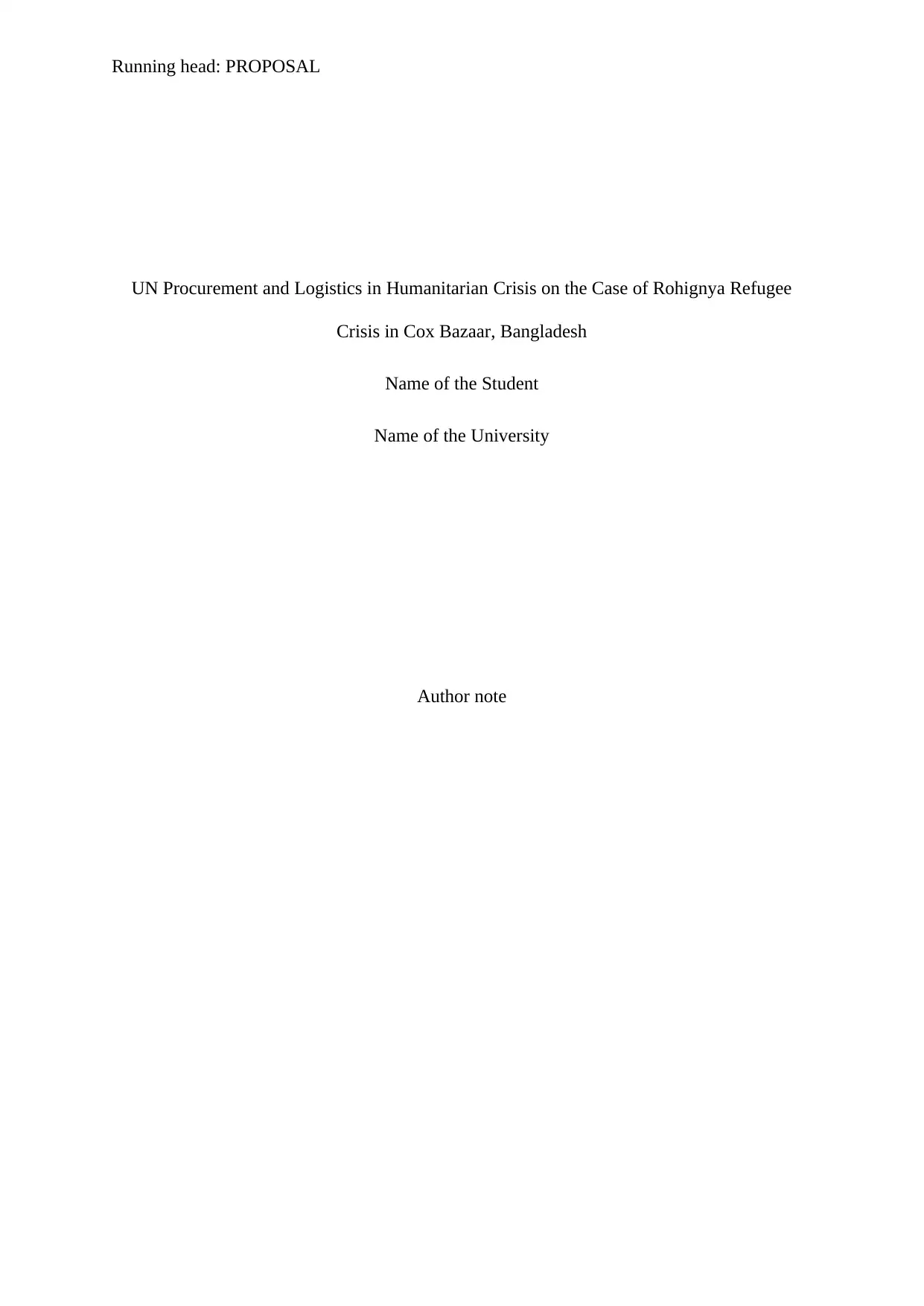
Running head: PROPOSAL
UN Procurement and Logistics in Humanitarian Crisis on the Case of Rohignya Refugee
Crisis in Cox Bazaar, Bangladesh
Name of the Student
Name of the University
Author note
UN Procurement and Logistics in Humanitarian Crisis on the Case of Rohignya Refugee
Crisis in Cox Bazaar, Bangladesh
Name of the Student
Name of the University
Author note
Paraphrase This Document
Need a fresh take? Get an instant paraphrase of this document with our AI Paraphraser
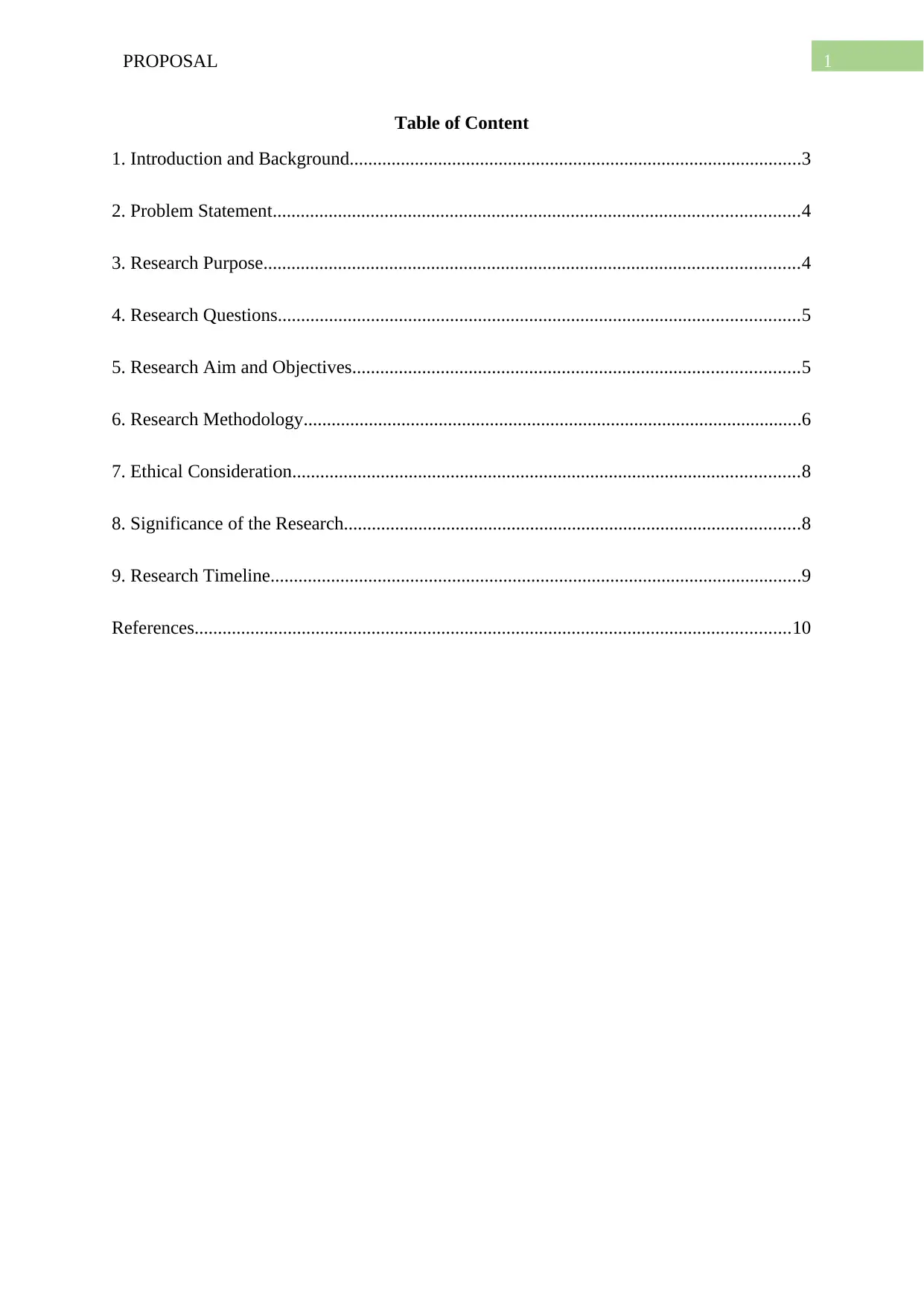
1PROPOSAL
Table of Content
1. Introduction and Background.................................................................................................3
2. Problem Statement.................................................................................................................4
3. Research Purpose...................................................................................................................4
4. Research Questions................................................................................................................5
5. Research Aim and Objectives................................................................................................5
6. Research Methodology...........................................................................................................6
7. Ethical Consideration.............................................................................................................8
8. Significance of the Research..................................................................................................8
9. Research Timeline..................................................................................................................9
References................................................................................................................................10
Table of Content
1. Introduction and Background.................................................................................................3
2. Problem Statement.................................................................................................................4
3. Research Purpose...................................................................................................................4
4. Research Questions................................................................................................................5
5. Research Aim and Objectives................................................................................................5
6. Research Methodology...........................................................................................................6
7. Ethical Consideration.............................................................................................................8
8. Significance of the Research..................................................................................................8
9. Research Timeline..................................................................................................................9
References................................................................................................................................10
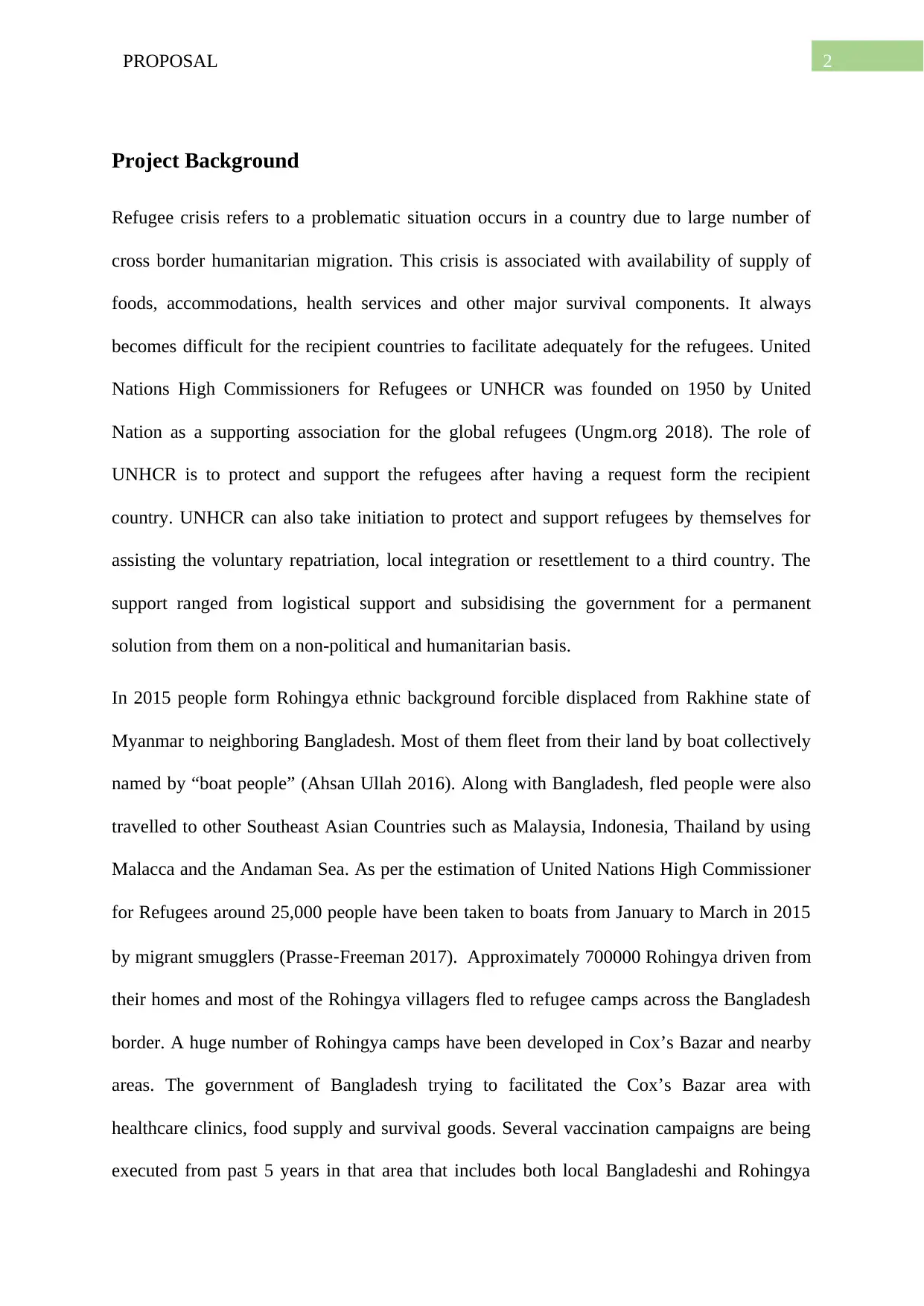
2PROPOSAL
Project Background
Refugee crisis refers to a problematic situation occurs in a country due to large number of
cross border humanitarian migration. This crisis is associated with availability of supply of
foods, accommodations, health services and other major survival components. It always
becomes difficult for the recipient countries to facilitate adequately for the refugees. United
Nations High Commissioners for Refugees or UNHCR was founded on 1950 by United
Nation as a supporting association for the global refugees (Ungm.org 2018). The role of
UNHCR is to protect and support the refugees after having a request form the recipient
country. UNHCR can also take initiation to protect and support refugees by themselves for
assisting the voluntary repatriation, local integration or resettlement to a third country. The
support ranged from logistical support and subsidising the government for a permanent
solution from them on a non-political and humanitarian basis.
In 2015 people form Rohingya ethnic background forcible displaced from Rakhine state of
Myanmar to neighboring Bangladesh. Most of them fleet from their land by boat collectively
named by “boat people” (Ahsan Ullah 2016). Along with Bangladesh, fled people were also
travelled to other Southeast Asian Countries such as Malaysia, Indonesia, Thailand by using
Malacca and the Andaman Sea. As per the estimation of United Nations High Commissioner
for Refugees around 25,000 people have been taken to boats from January to March in 2015
by migrant smugglers (Prasse‐Freeman 2017). Approximately 700000 Rohingya driven from
their homes and most of the Rohingya villagers fled to refugee camps across the Bangladesh
border. A huge number of Rohingya camps have been developed in Cox’s Bazar and nearby
areas. The government of Bangladesh trying to facilitated the Cox’s Bazar area with
healthcare clinics, food supply and survival goods. Several vaccination campaigns are being
executed from past 5 years in that area that includes both local Bangladeshi and Rohingya
Project Background
Refugee crisis refers to a problematic situation occurs in a country due to large number of
cross border humanitarian migration. This crisis is associated with availability of supply of
foods, accommodations, health services and other major survival components. It always
becomes difficult for the recipient countries to facilitate adequately for the refugees. United
Nations High Commissioners for Refugees or UNHCR was founded on 1950 by United
Nation as a supporting association for the global refugees (Ungm.org 2018). The role of
UNHCR is to protect and support the refugees after having a request form the recipient
country. UNHCR can also take initiation to protect and support refugees by themselves for
assisting the voluntary repatriation, local integration or resettlement to a third country. The
support ranged from logistical support and subsidising the government for a permanent
solution from them on a non-political and humanitarian basis.
In 2015 people form Rohingya ethnic background forcible displaced from Rakhine state of
Myanmar to neighboring Bangladesh. Most of them fleet from their land by boat collectively
named by “boat people” (Ahsan Ullah 2016). Along with Bangladesh, fled people were also
travelled to other Southeast Asian Countries such as Malaysia, Indonesia, Thailand by using
Malacca and the Andaman Sea. As per the estimation of United Nations High Commissioner
for Refugees around 25,000 people have been taken to boats from January to March in 2015
by migrant smugglers (Prasse‐Freeman 2017). Approximately 700000 Rohingya driven from
their homes and most of the Rohingya villagers fled to refugee camps across the Bangladesh
border. A huge number of Rohingya camps have been developed in Cox’s Bazar and nearby
areas. The government of Bangladesh trying to facilitated the Cox’s Bazar area with
healthcare clinics, food supply and survival goods. Several vaccination campaigns are being
executed from past 5 years in that area that includes both local Bangladeshi and Rohingya
⊘ This is a preview!⊘
Do you want full access?
Subscribe today to unlock all pages.

Trusted by 1+ million students worldwide
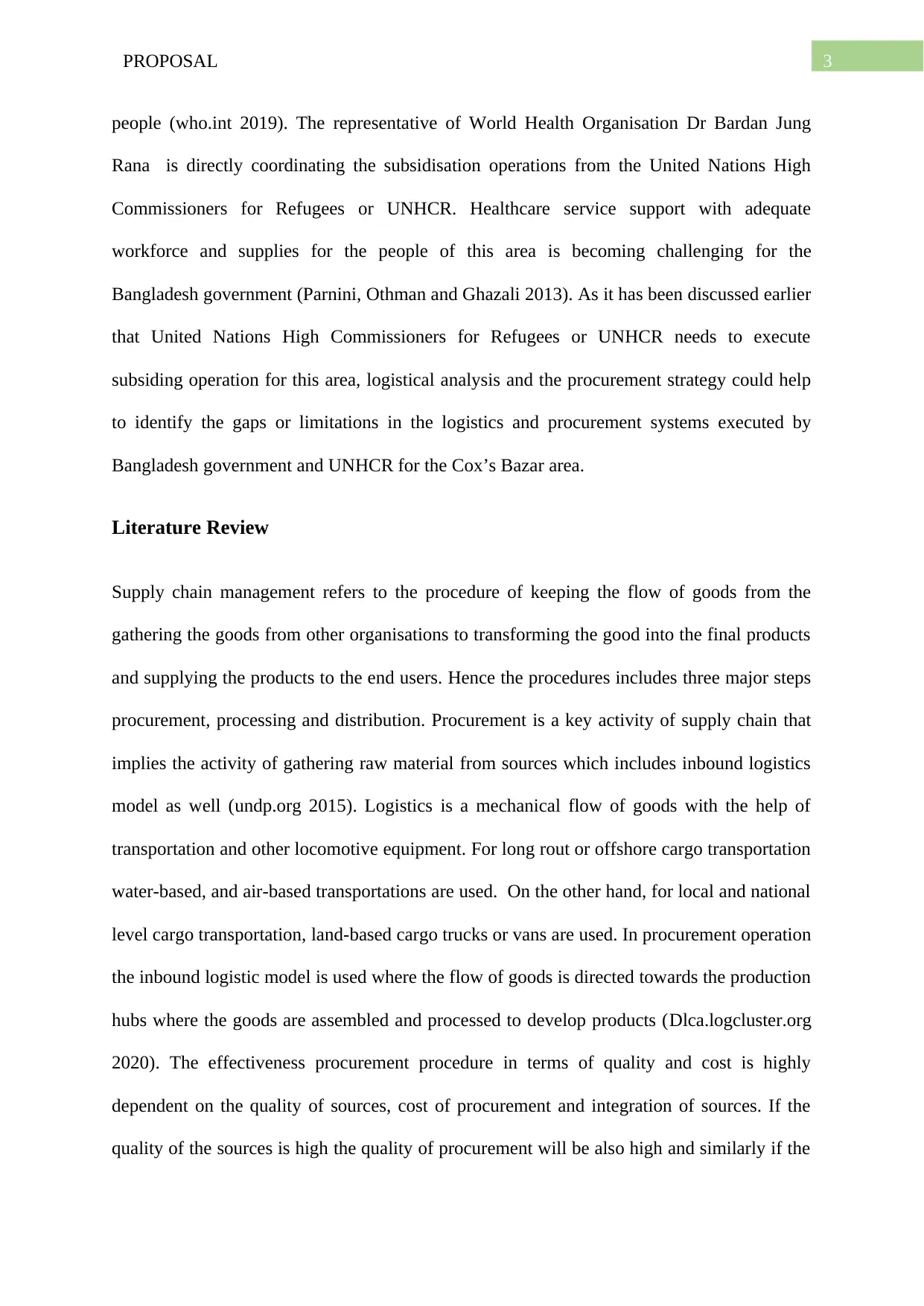
3PROPOSAL
people (who.int 2019). The representative of World Health Organisation Dr Bardan Jung
Rana is directly coordinating the subsidisation operations from the United Nations High
Commissioners for Refugees or UNHCR. Healthcare service support with adequate
workforce and supplies for the people of this area is becoming challenging for the
Bangladesh government (Parnini, Othman and Ghazali 2013). As it has been discussed earlier
that United Nations High Commissioners for Refugees or UNHCR needs to execute
subsiding operation for this area, logistical analysis and the procurement strategy could help
to identify the gaps or limitations in the logistics and procurement systems executed by
Bangladesh government and UNHCR for the Cox’s Bazar area.
Literature Review
Supply chain management refers to the procedure of keeping the flow of goods from the
gathering the goods from other organisations to transforming the good into the final products
and supplying the products to the end users. Hence the procedures includes three major steps
procurement, processing and distribution. Procurement is a key activity of supply chain that
implies the activity of gathering raw material from sources which includes inbound logistics
model as well (undp.org 2015). Logistics is a mechanical flow of goods with the help of
transportation and other locomotive equipment. For long rout or offshore cargo transportation
water-based, and air-based transportations are used. On the other hand, for local and national
level cargo transportation, land-based cargo trucks or vans are used. In procurement operation
the inbound logistic model is used where the flow of goods is directed towards the production
hubs where the goods are assembled and processed to develop products (Dlca.logcluster.org
2020). The effectiveness procurement procedure in terms of quality and cost is highly
dependent on the quality of sources, cost of procurement and integration of sources. If the
quality of the sources is high the quality of procurement will be also high and similarly if the
people (who.int 2019). The representative of World Health Organisation Dr Bardan Jung
Rana is directly coordinating the subsidisation operations from the United Nations High
Commissioners for Refugees or UNHCR. Healthcare service support with adequate
workforce and supplies for the people of this area is becoming challenging for the
Bangladesh government (Parnini, Othman and Ghazali 2013). As it has been discussed earlier
that United Nations High Commissioners for Refugees or UNHCR needs to execute
subsiding operation for this area, logistical analysis and the procurement strategy could help
to identify the gaps or limitations in the logistics and procurement systems executed by
Bangladesh government and UNHCR for the Cox’s Bazar area.
Literature Review
Supply chain management refers to the procedure of keeping the flow of goods from the
gathering the goods from other organisations to transforming the good into the final products
and supplying the products to the end users. Hence the procedures includes three major steps
procurement, processing and distribution. Procurement is a key activity of supply chain that
implies the activity of gathering raw material from sources which includes inbound logistics
model as well (undp.org 2015). Logistics is a mechanical flow of goods with the help of
transportation and other locomotive equipment. For long rout or offshore cargo transportation
water-based, and air-based transportations are used. On the other hand, for local and national
level cargo transportation, land-based cargo trucks or vans are used. In procurement operation
the inbound logistic model is used where the flow of goods is directed towards the production
hubs where the goods are assembled and processed to develop products (Dlca.logcluster.org
2020). The effectiveness procurement procedure in terms of quality and cost is highly
dependent on the quality of sources, cost of procurement and integration of sources. If the
quality of the sources is high the quality of procurement will be also high and similarly if the
Paraphrase This Document
Need a fresh take? Get an instant paraphrase of this document with our AI Paraphraser
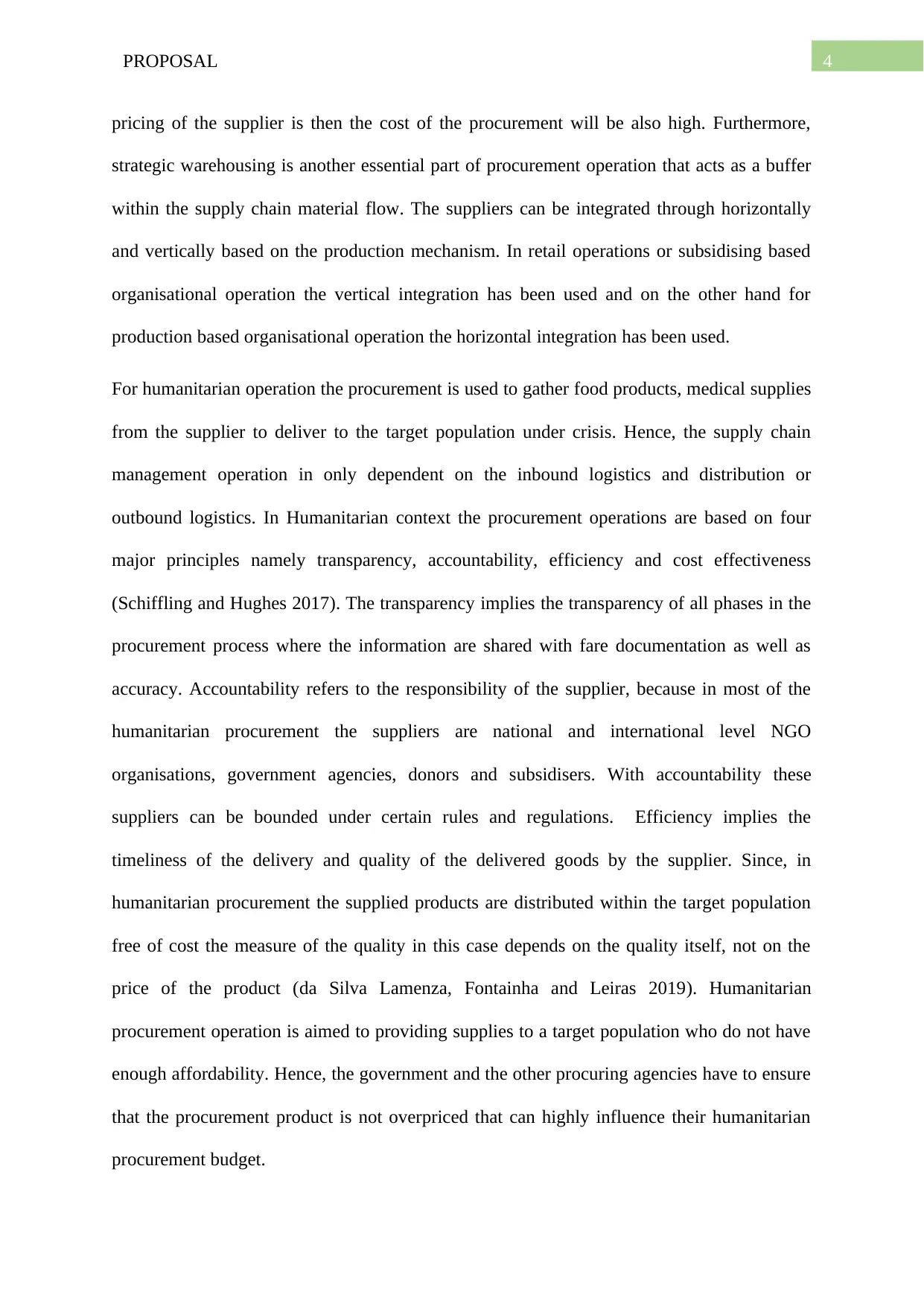
4PROPOSAL
pricing of the supplier is then the cost of the procurement will be also high. Furthermore,
strategic warehousing is another essential part of procurement operation that acts as a buffer
within the supply chain material flow. The suppliers can be integrated through horizontally
and vertically based on the production mechanism. In retail operations or subsidising based
organisational operation the vertical integration has been used and on the other hand for
production based organisational operation the horizontal integration has been used.
For humanitarian operation the procurement is used to gather food products, medical supplies
from the supplier to deliver to the target population under crisis. Hence, the supply chain
management operation in only dependent on the inbound logistics and distribution or
outbound logistics. In Humanitarian context the procurement operations are based on four
major principles namely transparency, accountability, efficiency and cost effectiveness
(Schiffling and Hughes 2017). The transparency implies the transparency of all phases in the
procurement process where the information are shared with fare documentation as well as
accuracy. Accountability refers to the responsibility of the supplier, because in most of the
humanitarian procurement the suppliers are national and international level NGO
organisations, government agencies, donors and subsidisers. With accountability these
suppliers can be bounded under certain rules and regulations. Efficiency implies the
timeliness of the delivery and quality of the delivered goods by the supplier. Since, in
humanitarian procurement the supplied products are distributed within the target population
free of cost the measure of the quality in this case depends on the quality itself, not on the
price of the product (da Silva Lamenza, Fontainha and Leiras 2019). Humanitarian
procurement operation is aimed to providing supplies to a target population who do not have
enough affordability. Hence, the government and the other procuring agencies have to ensure
that the procurement product is not overpriced that can highly influence their humanitarian
procurement budget.
pricing of the supplier is then the cost of the procurement will be also high. Furthermore,
strategic warehousing is another essential part of procurement operation that acts as a buffer
within the supply chain material flow. The suppliers can be integrated through horizontally
and vertically based on the production mechanism. In retail operations or subsidising based
organisational operation the vertical integration has been used and on the other hand for
production based organisational operation the horizontal integration has been used.
For humanitarian operation the procurement is used to gather food products, medical supplies
from the supplier to deliver to the target population under crisis. Hence, the supply chain
management operation in only dependent on the inbound logistics and distribution or
outbound logistics. In Humanitarian context the procurement operations are based on four
major principles namely transparency, accountability, efficiency and cost effectiveness
(Schiffling and Hughes 2017). The transparency implies the transparency of all phases in the
procurement process where the information are shared with fare documentation as well as
accuracy. Accountability refers to the responsibility of the supplier, because in most of the
humanitarian procurement the suppliers are national and international level NGO
organisations, government agencies, donors and subsidisers. With accountability these
suppliers can be bounded under certain rules and regulations. Efficiency implies the
timeliness of the delivery and quality of the delivered goods by the supplier. Since, in
humanitarian procurement the supplied products are distributed within the target population
free of cost the measure of the quality in this case depends on the quality itself, not on the
price of the product (da Silva Lamenza, Fontainha and Leiras 2019). Humanitarian
procurement operation is aimed to providing supplies to a target population who do not have
enough affordability. Hence, the government and the other procuring agencies have to ensure
that the procurement product is not overpriced that can highly influence their humanitarian
procurement budget.
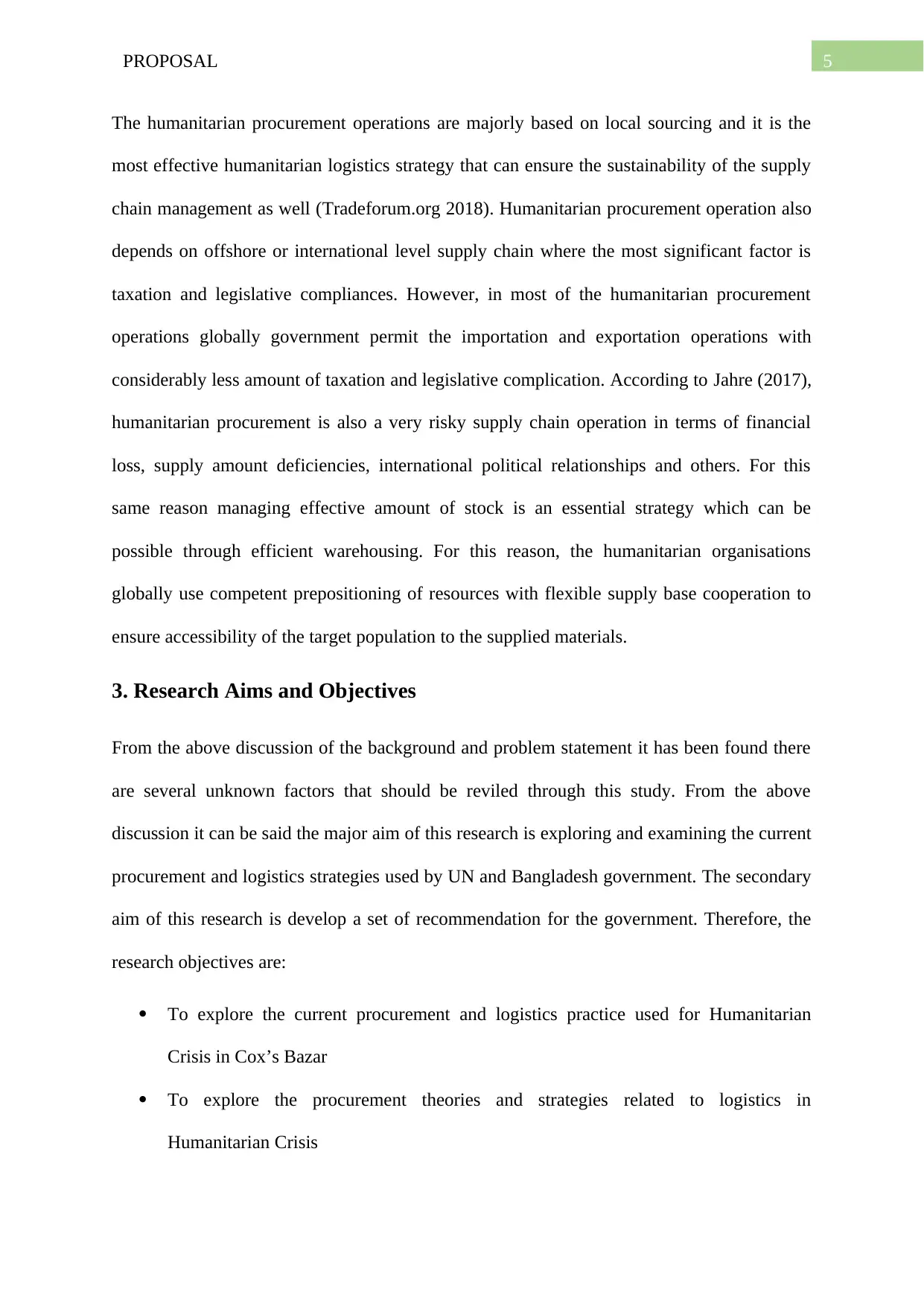
5PROPOSAL
The humanitarian procurement operations are majorly based on local sourcing and it is the
most effective humanitarian logistics strategy that can ensure the sustainability of the supply
chain management as well (Tradeforum.org 2018). Humanitarian procurement operation also
depends on offshore or international level supply chain where the most significant factor is
taxation and legislative compliances. However, in most of the humanitarian procurement
operations globally government permit the importation and exportation operations with
considerably less amount of taxation and legislative complication. According to Jahre (2017),
humanitarian procurement is also a very risky supply chain operation in terms of financial
loss, supply amount deficiencies, international political relationships and others. For this
same reason managing effective amount of stock is an essential strategy which can be
possible through efficient warehousing. For this reason, the humanitarian organisations
globally use competent prepositioning of resources with flexible supply base cooperation to
ensure accessibility of the target population to the supplied materials.
3. Research Aims and Objectives
From the above discussion of the background and problem statement it has been found there
are several unknown factors that should be reviled through this study. From the above
discussion it can be said the major aim of this research is exploring and examining the current
procurement and logistics strategies used by UN and Bangladesh government. The secondary
aim of this research is develop a set of recommendation for the government. Therefore, the
research objectives are:
To explore the current procurement and logistics practice used for Humanitarian
Crisis in Cox’s Bazar
To explore the procurement theories and strategies related to logistics in
Humanitarian Crisis
The humanitarian procurement operations are majorly based on local sourcing and it is the
most effective humanitarian logistics strategy that can ensure the sustainability of the supply
chain management as well (Tradeforum.org 2018). Humanitarian procurement operation also
depends on offshore or international level supply chain where the most significant factor is
taxation and legislative compliances. However, in most of the humanitarian procurement
operations globally government permit the importation and exportation operations with
considerably less amount of taxation and legislative complication. According to Jahre (2017),
humanitarian procurement is also a very risky supply chain operation in terms of financial
loss, supply amount deficiencies, international political relationships and others. For this
same reason managing effective amount of stock is an essential strategy which can be
possible through efficient warehousing. For this reason, the humanitarian organisations
globally use competent prepositioning of resources with flexible supply base cooperation to
ensure accessibility of the target population to the supplied materials.
3. Research Aims and Objectives
From the above discussion of the background and problem statement it has been found there
are several unknown factors that should be reviled through this study. From the above
discussion it can be said the major aim of this research is exploring and examining the current
procurement and logistics strategies used by UN and Bangladesh government. The secondary
aim of this research is develop a set of recommendation for the government. Therefore, the
research objectives are:
To explore the current procurement and logistics practice used for Humanitarian
Crisis in Cox’s Bazar
To explore the procurement theories and strategies related to logistics in
Humanitarian Crisis
⊘ This is a preview!⊘
Do you want full access?
Subscribe today to unlock all pages.

Trusted by 1+ million students worldwide
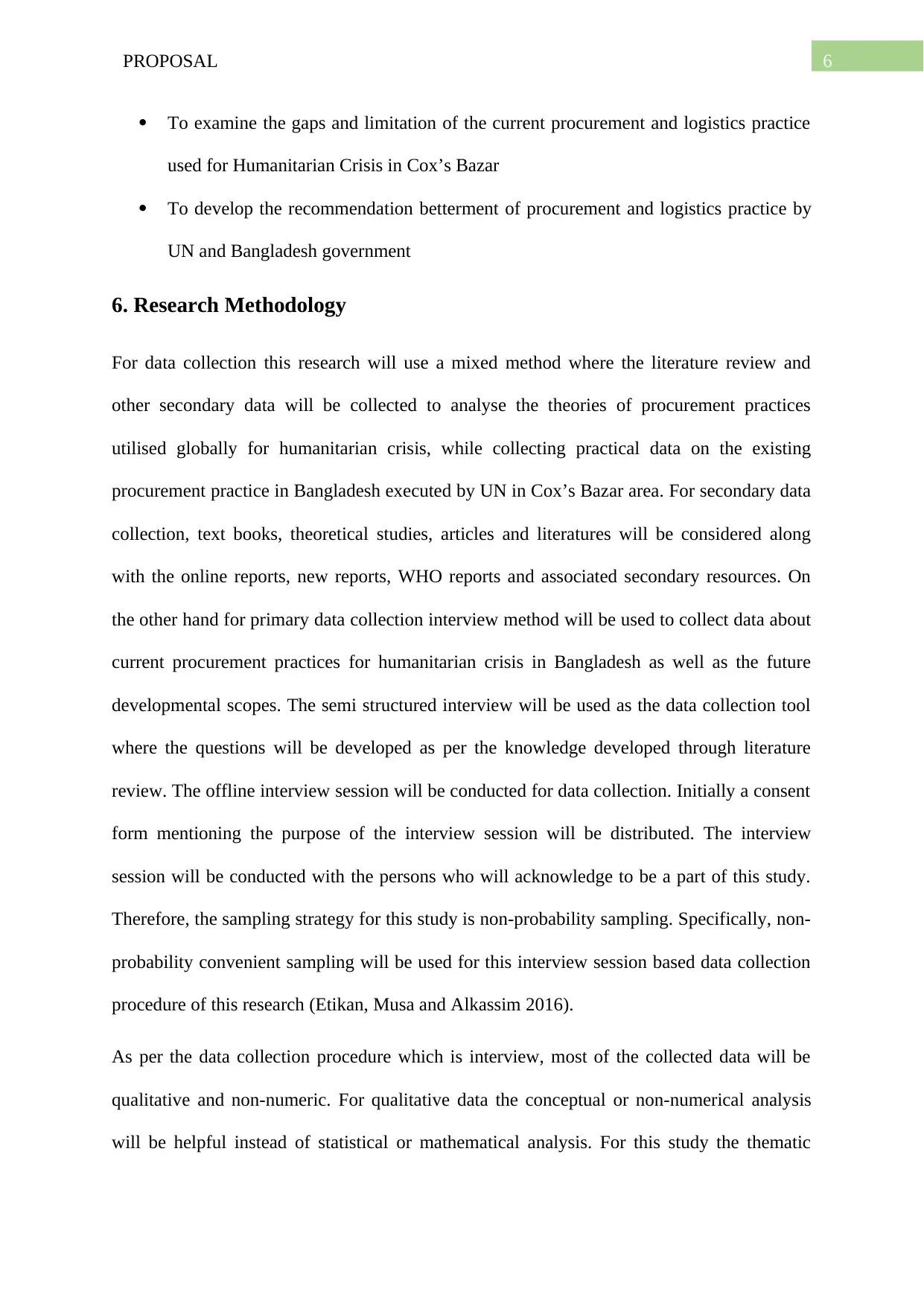
6PROPOSAL
To examine the gaps and limitation of the current procurement and logistics practice
used for Humanitarian Crisis in Cox’s Bazar
To develop the recommendation betterment of procurement and logistics practice by
UN and Bangladesh government
6. Research Methodology
For data collection this research will use a mixed method where the literature review and
other secondary data will be collected to analyse the theories of procurement practices
utilised globally for humanitarian crisis, while collecting practical data on the existing
procurement practice in Bangladesh executed by UN in Cox’s Bazar area. For secondary data
collection, text books, theoretical studies, articles and literatures will be considered along
with the online reports, new reports, WHO reports and associated secondary resources. On
the other hand for primary data collection interview method will be used to collect data about
current procurement practices for humanitarian crisis in Bangladesh as well as the future
developmental scopes. The semi structured interview will be used as the data collection tool
where the questions will be developed as per the knowledge developed through literature
review. The offline interview session will be conducted for data collection. Initially a consent
form mentioning the purpose of the interview session will be distributed. The interview
session will be conducted with the persons who will acknowledge to be a part of this study.
Therefore, the sampling strategy for this study is non-probability sampling. Specifically, non-
probability convenient sampling will be used for this interview session based data collection
procedure of this research (Etikan, Musa and Alkassim 2016).
As per the data collection procedure which is interview, most of the collected data will be
qualitative and non-numeric. For qualitative data the conceptual or non-numerical analysis
will be helpful instead of statistical or mathematical analysis. For this study the thematic
To examine the gaps and limitation of the current procurement and logistics practice
used for Humanitarian Crisis in Cox’s Bazar
To develop the recommendation betterment of procurement and logistics practice by
UN and Bangladesh government
6. Research Methodology
For data collection this research will use a mixed method where the literature review and
other secondary data will be collected to analyse the theories of procurement practices
utilised globally for humanitarian crisis, while collecting practical data on the existing
procurement practice in Bangladesh executed by UN in Cox’s Bazar area. For secondary data
collection, text books, theoretical studies, articles and literatures will be considered along
with the online reports, new reports, WHO reports and associated secondary resources. On
the other hand for primary data collection interview method will be used to collect data about
current procurement practices for humanitarian crisis in Bangladesh as well as the future
developmental scopes. The semi structured interview will be used as the data collection tool
where the questions will be developed as per the knowledge developed through literature
review. The offline interview session will be conducted for data collection. Initially a consent
form mentioning the purpose of the interview session will be distributed. The interview
session will be conducted with the persons who will acknowledge to be a part of this study.
Therefore, the sampling strategy for this study is non-probability sampling. Specifically, non-
probability convenient sampling will be used for this interview session based data collection
procedure of this research (Etikan, Musa and Alkassim 2016).
As per the data collection procedure which is interview, most of the collected data will be
qualitative and non-numeric. For qualitative data the conceptual or non-numerical analysis
will be helpful instead of statistical or mathematical analysis. For this study the thematic
Paraphrase This Document
Need a fresh take? Get an instant paraphrase of this document with our AI Paraphraser
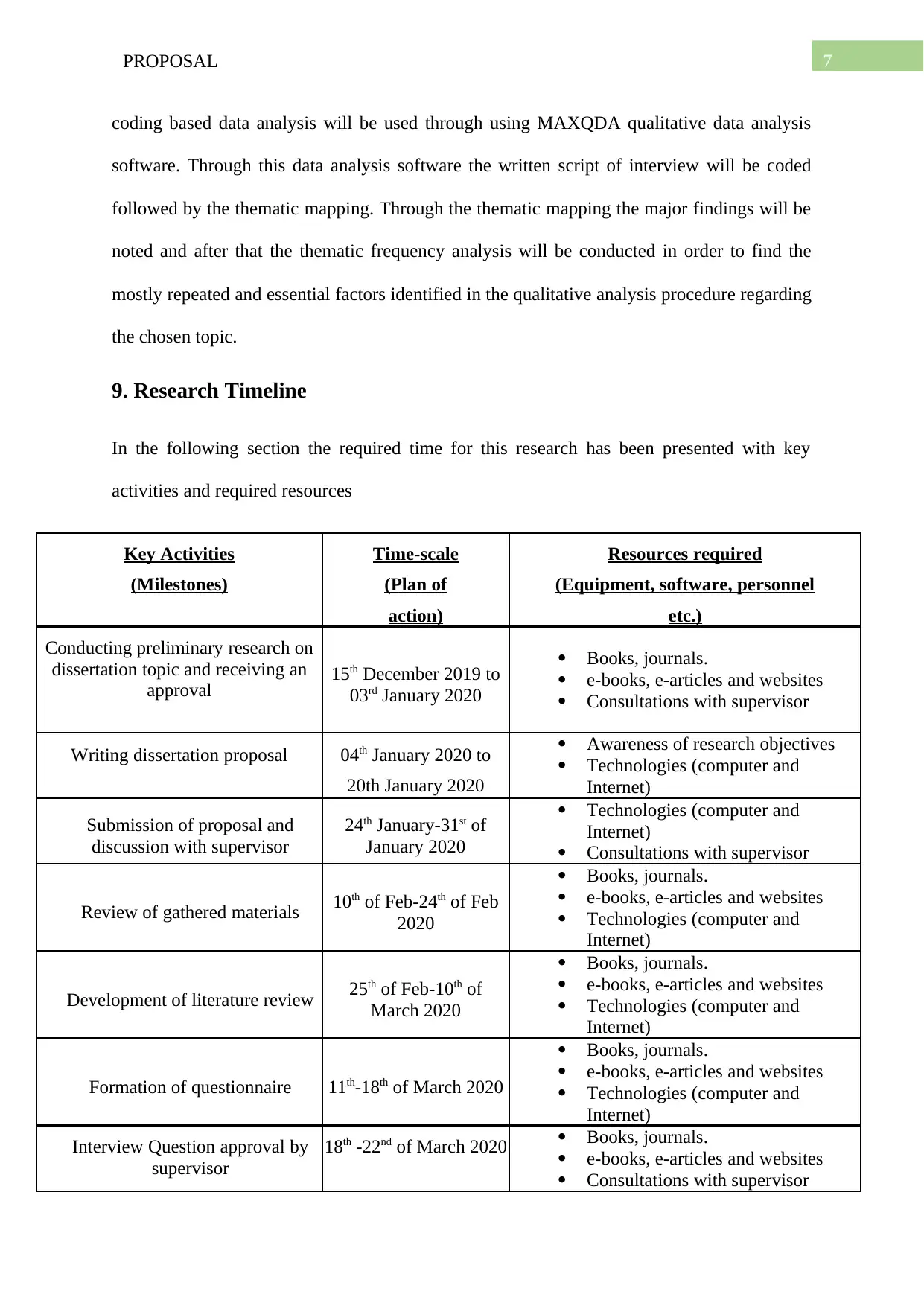
7PROPOSAL
coding based data analysis will be used through using MAXQDA qualitative data analysis
software. Through this data analysis software the written script of interview will be coded
followed by the thematic mapping. Through the thematic mapping the major findings will be
noted and after that the thematic frequency analysis will be conducted in order to find the
mostly repeated and essential factors identified in the qualitative analysis procedure regarding
the chosen topic.
9. Research Timeline
In the following section the required time for this research has been presented with key
activities and required resources
Key Activities Time-scale Resources required
(Milestones) (Plan of (Equipment, software, personnel
action) etc.)
Conducting preliminary research on
dissertation topic and receiving an
approval 15th December 2019 to
03rd January 2020
Books, journals.
e-books, e-articles and websites
Consultations with supervisor
Writing dissertation proposal 04th January 2020 to
20th January 2020
Awareness of research objectives
Technologies (computer and
Internet)
Submission of proposal and
discussion with supervisor
24th January-31st of
January 2020
Technologies (computer and
Internet)
Consultations with supervisor
Review of gathered materials 10th of Feb-24th of Feb
2020
Books, journals.
e-books, e-articles and websites
Technologies (computer and
Internet)
Development of literature review 25th of Feb-10th of
March 2020
Books, journals.
e-books, e-articles and websites
Technologies (computer and
Internet)
Formation of questionnaire 11th-18th of March 2020
Books, journals.
e-books, e-articles and websites
Technologies (computer and
Internet)
Interview Question approval by
supervisor
18th -22nd of March 2020 Books, journals.
e-books, e-articles and websites
Consultations with supervisor
coding based data analysis will be used through using MAXQDA qualitative data analysis
software. Through this data analysis software the written script of interview will be coded
followed by the thematic mapping. Through the thematic mapping the major findings will be
noted and after that the thematic frequency analysis will be conducted in order to find the
mostly repeated and essential factors identified in the qualitative analysis procedure regarding
the chosen topic.
9. Research Timeline
In the following section the required time for this research has been presented with key
activities and required resources
Key Activities Time-scale Resources required
(Milestones) (Plan of (Equipment, software, personnel
action) etc.)
Conducting preliminary research on
dissertation topic and receiving an
approval 15th December 2019 to
03rd January 2020
Books, journals.
e-books, e-articles and websites
Consultations with supervisor
Writing dissertation proposal 04th January 2020 to
20th January 2020
Awareness of research objectives
Technologies (computer and
Internet)
Submission of proposal and
discussion with supervisor
24th January-31st of
January 2020
Technologies (computer and
Internet)
Consultations with supervisor
Review of gathered materials 10th of Feb-24th of Feb
2020
Books, journals.
e-books, e-articles and websites
Technologies (computer and
Internet)
Development of literature review 25th of Feb-10th of
March 2020
Books, journals.
e-books, e-articles and websites
Technologies (computer and
Internet)
Formation of questionnaire 11th-18th of March 2020
Books, journals.
e-books, e-articles and websites
Technologies (computer and
Internet)
Interview Question approval by
supervisor
18th -22nd of March 2020 Books, journals.
e-books, e-articles and websites
Consultations with supervisor
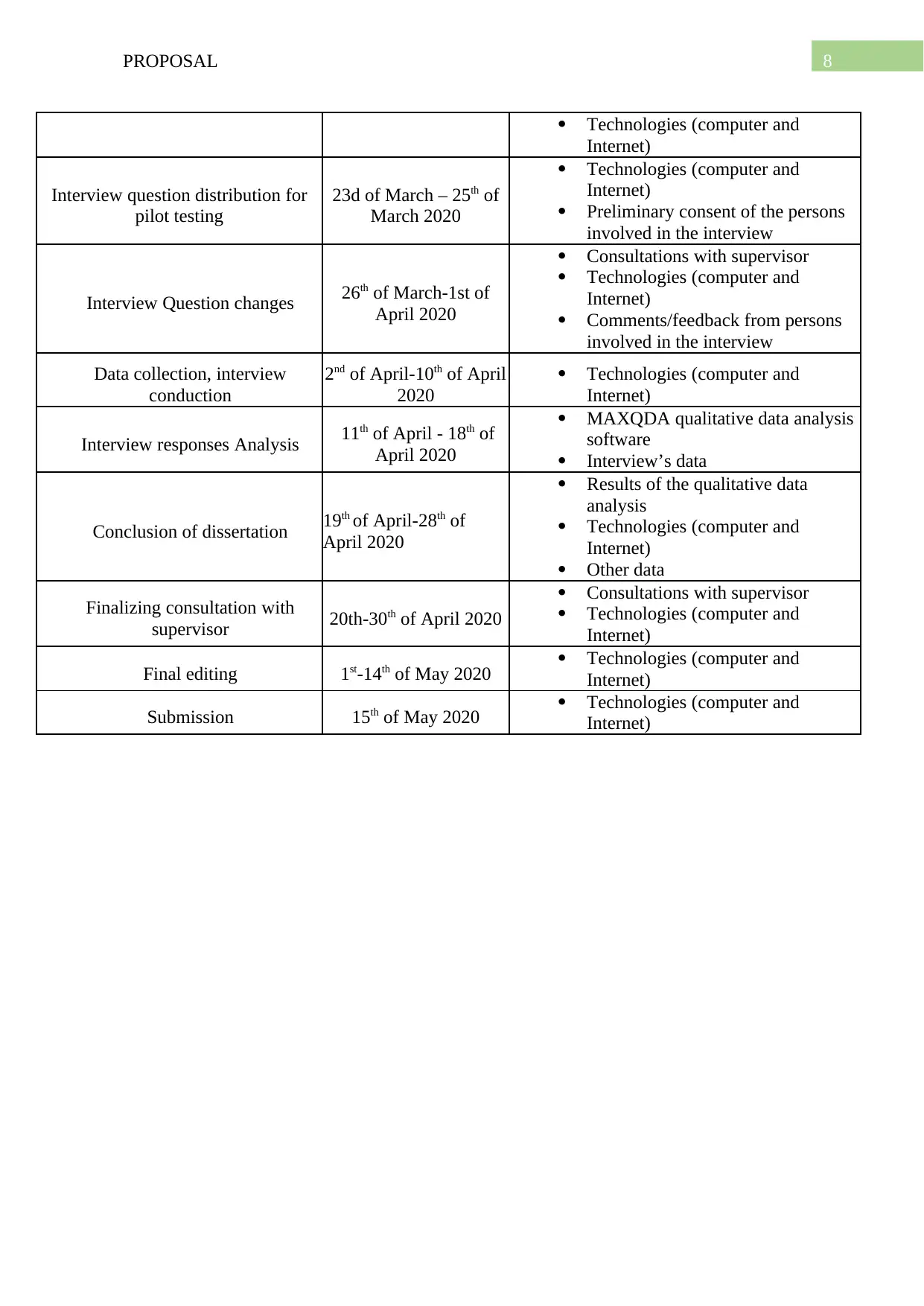
8PROPOSAL
Technologies (computer and
Internet)
Interview question distribution for
pilot testing
23d of March – 25th of
March 2020
Technologies (computer and
Internet)
Preliminary consent of the persons
involved in the interview
Interview Question changes 26th of March-1st of
April 2020
Consultations with supervisor
Technologies (computer and
Internet)
Comments/feedback from persons
involved in the interview
Data collection, interview
conduction
2nd of April-10th of April
2020
Technologies (computer and
Internet)
Interview responses Analysis 11th of April - 18th of
April 2020
MAXQDA qualitative data analysis
software
Interview’s data
Conclusion of dissertation 19th of April-28th of
April 2020
Results of the qualitative data
analysis
Technologies (computer and
Internet)
Other data
Finalizing consultation with
supervisor 20th-30th of April 2020
Consultations with supervisor
Technologies (computer and
Internet)
Final editing 1st-14th of May 2020 Technologies (computer and
Internet)
Submission 15th of May 2020 Technologies (computer and
Internet)
Technologies (computer and
Internet)
Interview question distribution for
pilot testing
23d of March – 25th of
March 2020
Technologies (computer and
Internet)
Preliminary consent of the persons
involved in the interview
Interview Question changes 26th of March-1st of
April 2020
Consultations with supervisor
Technologies (computer and
Internet)
Comments/feedback from persons
involved in the interview
Data collection, interview
conduction
2nd of April-10th of April
2020
Technologies (computer and
Internet)
Interview responses Analysis 11th of April - 18th of
April 2020
MAXQDA qualitative data analysis
software
Interview’s data
Conclusion of dissertation 19th of April-28th of
April 2020
Results of the qualitative data
analysis
Technologies (computer and
Internet)
Other data
Finalizing consultation with
supervisor 20th-30th of April 2020
Consultations with supervisor
Technologies (computer and
Internet)
Final editing 1st-14th of May 2020 Technologies (computer and
Internet)
Submission 15th of May 2020 Technologies (computer and
Internet)
⊘ This is a preview!⊘
Do you want full access?
Subscribe today to unlock all pages.

Trusted by 1+ million students worldwide
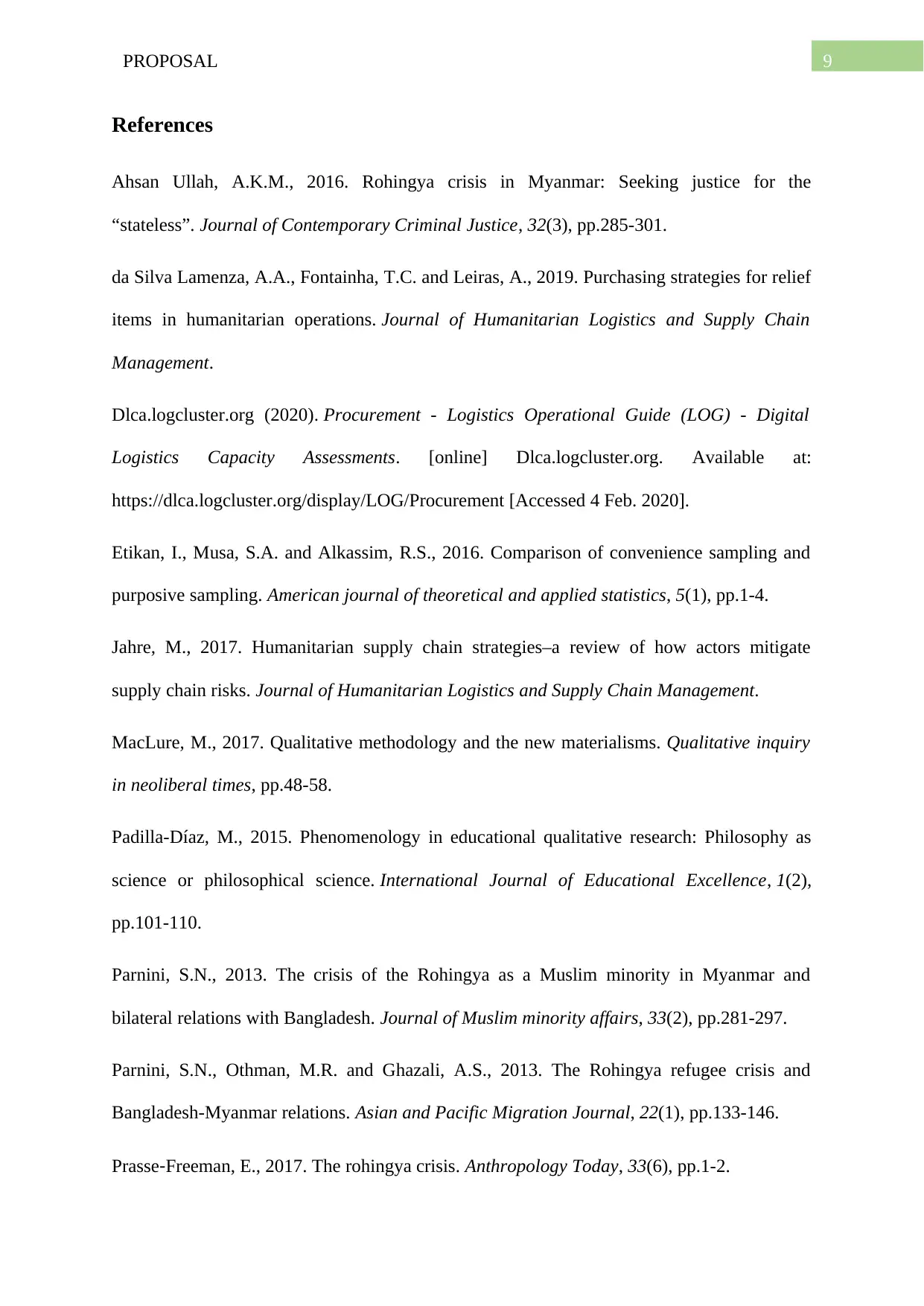
9PROPOSAL
References
Ahsan Ullah, A.K.M., 2016. Rohingya crisis in Myanmar: Seeking justice for the
“stateless”. Journal of Contemporary Criminal Justice, 32(3), pp.285-301.
da Silva Lamenza, A.A., Fontainha, T.C. and Leiras, A., 2019. Purchasing strategies for relief
items in humanitarian operations. Journal of Humanitarian Logistics and Supply Chain
Management.
Dlca.logcluster.org (2020). Procurement - Logistics Operational Guide (LOG) - Digital
Logistics Capacity Assessments. [online] Dlca.logcluster.org. Available at:
https://dlca.logcluster.org/display/LOG/Procurement [Accessed 4 Feb. 2020].
Etikan, I., Musa, S.A. and Alkassim, R.S., 2016. Comparison of convenience sampling and
purposive sampling. American journal of theoretical and applied statistics, 5(1), pp.1-4.
Jahre, M., 2017. Humanitarian supply chain strategies–a review of how actors mitigate
supply chain risks. Journal of Humanitarian Logistics and Supply Chain Management.
MacLure, M., 2017. Qualitative methodology and the new materialisms. Qualitative inquiry
in neoliberal times, pp.48-58.
Padilla-Díaz, M., 2015. Phenomenology in educational qualitative research: Philosophy as
science or philosophical science. International Journal of Educational Excellence, 1(2),
pp.101-110.
Parnini, S.N., 2013. The crisis of the Rohingya as a Muslim minority in Myanmar and
bilateral relations with Bangladesh. Journal of Muslim minority affairs, 33(2), pp.281-297.
Parnini, S.N., Othman, M.R. and Ghazali, A.S., 2013. The Rohingya refugee crisis and
Bangladesh-Myanmar relations. Asian and Pacific Migration Journal, 22(1), pp.133-146.
Prasse‐Freeman, E., 2017. The rohingya crisis. Anthropology Today, 33(6), pp.1-2.
References
Ahsan Ullah, A.K.M., 2016. Rohingya crisis in Myanmar: Seeking justice for the
“stateless”. Journal of Contemporary Criminal Justice, 32(3), pp.285-301.
da Silva Lamenza, A.A., Fontainha, T.C. and Leiras, A., 2019. Purchasing strategies for relief
items in humanitarian operations. Journal of Humanitarian Logistics and Supply Chain
Management.
Dlca.logcluster.org (2020). Procurement - Logistics Operational Guide (LOG) - Digital
Logistics Capacity Assessments. [online] Dlca.logcluster.org. Available at:
https://dlca.logcluster.org/display/LOG/Procurement [Accessed 4 Feb. 2020].
Etikan, I., Musa, S.A. and Alkassim, R.S., 2016. Comparison of convenience sampling and
purposive sampling. American journal of theoretical and applied statistics, 5(1), pp.1-4.
Jahre, M., 2017. Humanitarian supply chain strategies–a review of how actors mitigate
supply chain risks. Journal of Humanitarian Logistics and Supply Chain Management.
MacLure, M., 2017. Qualitative methodology and the new materialisms. Qualitative inquiry
in neoliberal times, pp.48-58.
Padilla-Díaz, M., 2015. Phenomenology in educational qualitative research: Philosophy as
science or philosophical science. International Journal of Educational Excellence, 1(2),
pp.101-110.
Parnini, S.N., 2013. The crisis of the Rohingya as a Muslim minority in Myanmar and
bilateral relations with Bangladesh. Journal of Muslim minority affairs, 33(2), pp.281-297.
Parnini, S.N., Othman, M.R. and Ghazali, A.S., 2013. The Rohingya refugee crisis and
Bangladesh-Myanmar relations. Asian and Pacific Migration Journal, 22(1), pp.133-146.
Prasse‐Freeman, E., 2017. The rohingya crisis. Anthropology Today, 33(6), pp.1-2.
Paraphrase This Document
Need a fresh take? Get an instant paraphrase of this document with our AI Paraphraser
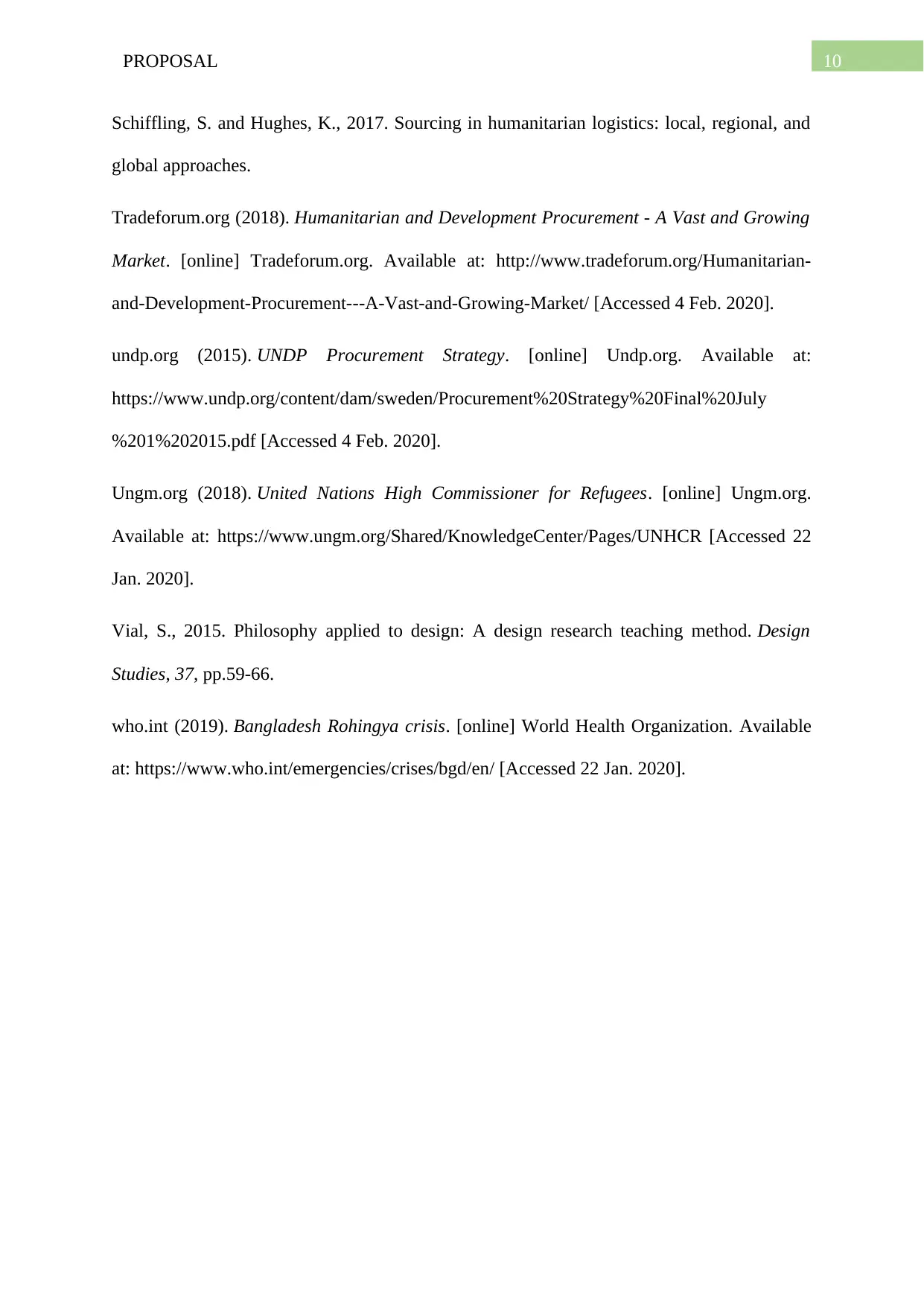
10PROPOSAL
Schiffling, S. and Hughes, K., 2017. Sourcing in humanitarian logistics: local, regional, and
global approaches.
Tradeforum.org (2018). Humanitarian and Development Procurement - A Vast and Growing
Market. [online] Tradeforum.org. Available at: http://www.tradeforum.org/Humanitarian-
and-Development-Procurement---A-Vast-and-Growing-Market/ [Accessed 4 Feb. 2020].
undp.org (2015). UNDP Procurement Strategy. [online] Undp.org. Available at:
https://www.undp.org/content/dam/sweden/Procurement%20Strategy%20Final%20July
%201%202015.pdf [Accessed 4 Feb. 2020].
Ungm.org (2018). United Nations High Commissioner for Refugees. [online] Ungm.org.
Available at: https://www.ungm.org/Shared/KnowledgeCenter/Pages/UNHCR [Accessed 22
Jan. 2020].
Vial, S., 2015. Philosophy applied to design: A design research teaching method. Design
Studies, 37, pp.59-66.
who.int (2019). Bangladesh Rohingya crisis. [online] World Health Organization. Available
at: https://www.who.int/emergencies/crises/bgd/en/ [Accessed 22 Jan. 2020].
Schiffling, S. and Hughes, K., 2017. Sourcing in humanitarian logistics: local, regional, and
global approaches.
Tradeforum.org (2018). Humanitarian and Development Procurement - A Vast and Growing
Market. [online] Tradeforum.org. Available at: http://www.tradeforum.org/Humanitarian-
and-Development-Procurement---A-Vast-and-Growing-Market/ [Accessed 4 Feb. 2020].
undp.org (2015). UNDP Procurement Strategy. [online] Undp.org. Available at:
https://www.undp.org/content/dam/sweden/Procurement%20Strategy%20Final%20July
%201%202015.pdf [Accessed 4 Feb. 2020].
Ungm.org (2018). United Nations High Commissioner for Refugees. [online] Ungm.org.
Available at: https://www.ungm.org/Shared/KnowledgeCenter/Pages/UNHCR [Accessed 22
Jan. 2020].
Vial, S., 2015. Philosophy applied to design: A design research teaching method. Design
Studies, 37, pp.59-66.
who.int (2019). Bangladesh Rohingya crisis. [online] World Health Organization. Available
at: https://www.who.int/emergencies/crises/bgd/en/ [Accessed 22 Jan. 2020].
1 out of 11
Related Documents
Your All-in-One AI-Powered Toolkit for Academic Success.
+13062052269
info@desklib.com
Available 24*7 on WhatsApp / Email
![[object Object]](/_next/static/media/star-bottom.7253800d.svg)
Unlock your academic potential
Copyright © 2020–2025 A2Z Services. All Rights Reserved. Developed and managed by ZUCOL.





